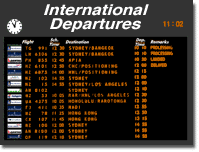
The New York Times recently published an article on Mark Cuban’s Landmark Theaters in its Digital Domain section. Entitled “Is Mark Cuban Missing the Big Picture?”, the article amounted to a mild (?) condemnation and questioning of Cuban’s dedication to digital cinemas. While Cuban, with a net worth estimated by Forbes at around US$1.8 billion, might “enjoy the presumption of possessing impeccable credentials as a business strategist and a technology futurist”, his foray into digital cinema is under question by the industry.
Not only do we belive Cuban is on the right track, we think he could get even bolder. The digital cinema market is about to get even bigger!
Around the globe airports are seeking to meet the ever increasing demands of transumers for new airport leisure experiences that mirror non-travel experiences. In addition, cinema advertisers, exhibitors, distributors and content providers are looking for untapped market segments that delivers growth similar to their entry into shopping malls/centres in the 70s.
DIFFUSION has been working on a digital cinema project with a select group of cinema and entertainment industry veterans for the past three years; approaching and meeting with a wide variety consultants, private equity firms, venture ca italists and suppliers in Australia, the United States, New Zealand and the United Kingdom to develop an extensive business case and plan.
We call it CINÉAIR (www.cineair.com), the world’s first airport cinema chain.
CINÉAIR is based on the current cinema multiplex model and much like Cuban's approach, each multiplex includes a number of fully automated digital cinemas. The big difference is that CINÉAIR cinemas are located AIRSIDE at selected international airport hubs, delivering a potential market of 8.5 billion people annually (1.2 billion more than the entire global cinema market). Cinema entry is via a self automated kiosk and turnstile system, priced on a Pay-Per-View (PPV) basis or through a Pre-Paid arrangement with major airlines, so it can be incorporated into airline tickets [...we note with interest that the EU has ruled that from February, airlines landing within the EU will need to provide meals and other compensation for delayed flights]. CINÉAIR Programming includes first-release major motion pictures and location-specific (i.e. tourist information services) or time-sensitive programs (i.e. major sporting events).
CINÉAIR is in the final development stage. We’ve been seeking an investor/s to help us develop the initial infrastructure and to launch the first site. We’ve done all the spade work, run the investment scenario, the development costs and the forecasts [...with attractive returns within five years]. Finally, we know which airports it can run in, we’ve identified them and we know many airports are already forseeing cinema as an important part of the new development mix for the future of airport retailing.
After the New York Times article we contacted Mark through his blog http://www.blogmaverick.com/ The maverick is yet to respond. Can you let him know we hoping to hear from him soon..
